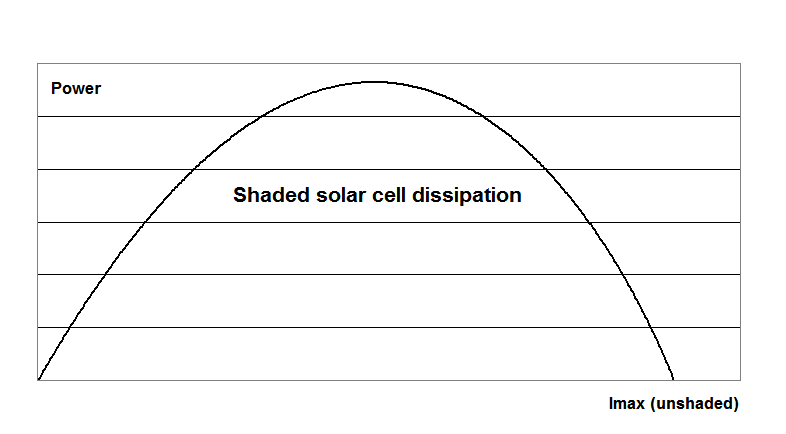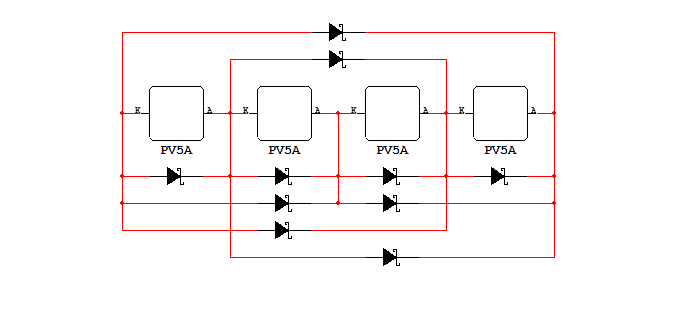Bypass diode simulations in solar panels
- Related articles
- Solar cells are current sources
- Series connected solar cells in a PV panel
- The need for bypass diodes
- Conventional and active bypass diodes
- Bypass diodes for hot-spot protection
- Conventional bypass diodes for minimized shadowing impact on PV panel power
- Active bypass diodes for minimized shadowing impact on PV panel power
- PV panel examples
- Multiple MPPs in partially-shaded PV modules
- Bypass diode wiring at the Maxun One solar bike
- Reverse bias thermal runaway
Related articles
Solar cells are current sources
It is important to know that solar cells are current sources. At solar panels, the solar cells are series connected, the same way as batteries are used. Initially, this seems uncomplicated. But it isn’t. Connecting solar cells in series has many pitfalls because they are current sources. To understand this, I have made an image that explains the difference between current sources and voltage sources. Electric circuits with current sources are rare and therefore hard to understand. The behaviour of current sources is opposite to voltage sources. Voltage sources like to be left open and wired in series. Current sources, on the other hand, like to be short circuit and wired parallel. Because solar cells are wired in series this causes a lot of trouble, as we'll see.
 Differences between voltage and current source
Differences between voltage and current source
Series connected solar cells in a PV panel
Series wiring ideal current sources is not possible. But solar cells are junction diodes parallel to a current source and thus they are not ideal current sources. These junction diodes solve the problem:
The lowest solar cell current is the output current of the PV panel and the surplus current of each solar cell flows back through its diode.
The need for bypass diodes
The shadow problems of PV modules are caused by the fact that the solar cells, which are unequal current sources, are series connected. If you want to understand this subject, please read the comprehensive website on PV modules from Christiana Honsberg and Stuart Bowden here: http://www.pveducation.org/ and http://pvcdrom.pveducation.org/MODULE/Bypass.htm.
Summary, without using bypass diode, these are the problems caused by shadow:
- One single shaded solar cell already kills the entire panel’s power production.
- The shaded cell can be damaged or catch fire because of over heating. This is the so called hot-spot damage.
Available bypass diodes
See the article HERE.
Conventional and active bypass diodes
There are two types of bypass diodes: conventional and active, the latter were introduced in 2010 and are preferred.
Bypass diodes for hot-spot protection
The shaded solar cell power dissipation is dependant of the amount of shadow and the load. The maximum is when the cell is half shaded and the load is minimal:
 Shaded solar cell dissipation as a function of shadow
Shaded solar cell dissipation as a function of shadow
Here is a simulation of a 15 solar cell PV panel where one solar cell is half shaded. The shaded solar cell dissipates 19W when the load is 0.5Ω.
 PV panel bypass diode simulation
PV panel bypass diode simulation
Commonly, for hot-spot protection, one bypass diode per group of maximum 15 solar cells is used. Suppose we have a solar panel of 60 solar cells. Such a panel can be divided four groups of 15 cells. If only one solar cell in a group is shaded, we loss the solar power from the whole group. When two groups have a shaded solar cell, the total loss is already 50%. At mobile applications with often shadow, smaller groups are needed to minimize the shadowing impact.
Conventional bypass diodes for minimized shadowing impact on PV panel power
The simulations and conclusions below are based on the use of conventional P-N junction bypass diodes. Active bypass diodes were not available in 2010, when this article was written.
The second reason for using bypass diodes is minimizing shadowing impact on the PV panel power. We will likely conclude that using one conventional bypass diode per solar cell is the ultimate solution. But this is not true. If there is shadow at the solar panel, mostly more solar cells are shaded. In this case placing bypass diodes over groups of solar cells is better.
We discuss three bypass diode configurations, which are simulated with Multisim. The simulated bypass diodes are equal to the SBR20U40CT. The current at the maximum power point is 4.7A. For determining the loss we only treat the worst case of completely shaded cells. This is because it seldom occur that only one cell in a group is partly shaded.
PV panel voltage reduction caused by shadow when bypass diodes are placed across groups of solar cells:
- The voltage reduction is the number of cells in the group x voltage at maximum power (ca. 056V) + bypass diode forward voltage.
- The voltage reduction in case of more shaded groups is the sum of the voltage reduction per group.
Serial groups
In string 1, each solar cell has its own bypass diode. When a single solar cell is shaded, this configuration is optimal. When two adjacent solar cells are shaded, string 2 gives a higher output voltage, 0.82V instead of 0.53V. In practise we use larger groups of solar cells. Because of hot-spot protection the maximum amount of solar cells in a group is about 15.
 Bypass diodes serial groups configuration
Bypass diodes serial groups configuration
Overlapped groups
The wiring has to be kept simple; there are just a few possibilities for placing the bypass diodes. The overlapped or interlaced group configuration is a handy solution for the most PV panels. Like the serial groups, larger groups of solar cells will be used.
 Bypass diodes overlapped group configuration
Bypass diodes overlapped group configuration
Multilevel groups
Multiple levels of solar cell groups can deal with various shadow patterns. This example has the lowest loss in case of a single shaded solar cell and also when for instance the first two solar cells are shaded.
 Bypass diodes multilevel groups configuration
Bypass diodes multilevel groups configuration
Elaborating the above methods, theoretically, the following scheme is the ultimate solution for four solar cell PV panel. Every shadow pattern has the minimal power loss. However, this configuration is not feasible. For more solar cells, this will give a tremendous amount of bypass diodes and wiring. Also the total diodes leakage current is unacceptable.
 Maximal amount of bypass diodes
Maximal amount of bypass diodes
This design is patented, it is a typical example of a trivial patent: US Patent 6225793 "Solar power generation circuit including bypass diodes connected in parallel to groups of series connected solar cells".
Active bypass diodes for minimized shadowing impact on PV panel power
Active bypass diodes are a better alternative to conventional bypass diodes, the forward voltage is almost 0V. These are not simulated here. The best configuration for active bypass diodes is serial groups.
PV panel examples
The simulations and conclusions below are based on the use of conventional P-N junction bypass diodes. Here is an example of a PV panel with 25 solar cells. Because we want to keep the wiring simple, this is a practical solution for the placement of the bypass diodes.
 Solar panel with 25 solar cells
Solar panel with 25 solar cells
Examples of a PV panel with shadow
With 6 shaded solar cells the voltage loss = 6*0.55V + 0.29V:
 PV panel shading simulation with 6 shaded solar cells
PV panel shading simulation with 6 shaded solar cells
With 9 shaded solar cells the voltage loss = 9*0.55V + 2*0.29V:
 PV panel shading simulation with 9 shaded solar cells
PV panel shading simulation with 9 shaded solar cells
This example has a remarkable current distribution trough the solar cells and bypass diodes. IA = 3.09A, IB = 1.48A and IC = 1.61A. The voltage loss is higher than expected and can’t be calculated as the other shadow examples (9*0.55V + 2*0.29V). As we can see the current trough the top en bottom string is 3.1A instead of 4.7A. These solar cells produce less power. However, without the bypass diode D1 the voltage loss is even worse:
 PV panel bypass diode shading simulation, some solar cells not in MPP
PV panel bypass diode shading simulation, some solar cells not in MPP
Multiple MPPs in partially-shaded PV modules
A partially-shaded PV module may cause multiple maximum power points; I made a SPICE simulation of such a situation:
 SPICE simulation of multiple MPPs in a partially-shaded PV module
SPICE simulation of multiple MPPs in a partially-shaded PV module
The P-V characteristic shows three peaks, it is clear that the algorithm of a good MPPT must be able to deal with this:
 SPICE simulation of multiple maximum power points in a partially-shaded PV module
SPICE simulation of multiple maximum power points in a partially-shaded PV module
Bypass diode wiring at the Maxun One solar bike
More pypass diodes have been used on the side of the saddle because this is where the most shade is:
 Bypass diode wiring at the Maxun One solar bike
Bypass diode wiring at the Maxun One solar bike
 Bypass diode wiring at the Maxun One solar bike
Bypass diode wiring at the Maxun One solar bike
Reverse bias thermal runaway
The temperature of the forward biased bypass diode during shading can reach 150-200˚C. When the diode returns to its normal reverse-biased condition, the temperature of the diode will cool down. But this cooling down takes time. This is a critical point to understand. During this transition, the diode leakage will be very high due to the residual forward-biased self-heating (as high as 0.1A to 0.5A) and, in turn, can easily maintain self- heating due to high leakage current multiplied by the reverse bias voltage. The accumulated effect of the “shaded-to-unshaded” transition periods will degrade the lifetime of the bypass diodes.


